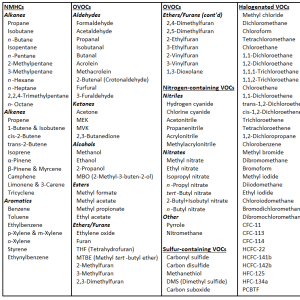TOGA measures volatile organic compounds (VOCs). TOGA was deployed with an Agilent quadrupole mass spectrometer from 2006 through 2018. Since 2019, the TOGA has been equipped with a TOFWERK high-resolution time-of-flight (HR-TOF) mass spectrometer detector (TOGA-TOF). Specific data will be obtained for radical precursors, tracers of anthropogenic and biogenic activities, tracers of urban and biomass combustion emissions, tracers of ocean emissions, products of oxidative processing, precursors to aerosol formation, and compounds important for aerosol modification and transformation. TOGA measures a wide range of VOCs with high sensitivity (low to sub-ppt), frequency (2 minutes or better), accuracy (20% or better), and precision (<3%). Over 100 species are routinely measured throughout the troposphere and lower stratosphere from the surface to 16 km or higher. See table for list of VOCs that have been quantified using TOGA and TOGA-TOF. The TOGA-TOF is contained in a dual extended HIAPER rack, weighs approximately 225 kg and consumes ~1 kW of power. The major components of the instrument are the inlet, cryogenic preconcentrator, gas chromatograph, time-of-flight mass spectrometer detector, zero air/calibration system, and the control/data acquisition system. All processes and data acquisition are computer controlled.
Trace Organic Gas Analyzer
Instrument Type
Measurements
Aircraft
Recent Missions
Point(s) of Contact
(POC; PI)
Range of Measurement
In situ
Data Delivery
Typically 24 hours for a preliminary subset of 20-30 field data quality VOCs. 2 months for a full dataset of preliminary data. 4-6 months for final data.
Weight
225.00 kg
Power:
(maximum )
1000.00 W
1000.00 W
Mission-Specific Writeups
Document
TRL
9
Website
Data Website
Publications
Apel, E.C., et al. (2003), A Fast-GC/MS system to measure C2 to C4 carbonyls, and methanol aboard aircraft, J. Geophys. Res., 108, 8794, doi:10.1029/2002JD003199.
Wang, S., et al. (2020), Global Atmospheric Budget of Acetone: Air‐Sea Exchange and the Contribution to Hydroxyl Radicals, J. Geophys. Res., 125, e2020JD032553, doi:10.1029/2020JD032553.
Zhu, L., et al. (2020), Validation of satellite formaldehyde (HCHO) retrievals using observations from 12 aircraft campaigns, Atmos. Chem. Phys., 20, 12329-12345, doi:10.5194/acp-20-12329-2020.
Bates, K.H., et al. (2021), The Global Budget of Atmospheric Methanol: New Constraints on Secondary, Oceanic, and Terrestrial Sources, J. Geophys. Res., 126, doi:10.1029/2020JD033439.
Chen, X., et al. (2021), HCOOH in the Remote Atmosphere: Constraints from Atmospheric Tomography (ATom) Airborne Observations, ACS Earth Space Chem., doi:10.1021/acsearthspacechem.1c00049.
Thompson, C., et al. (2021), The NASA Atmospheric Tomography (ATom) Mission: Imaging the Chemistry of the Global Atmosphere, Bull. Am. Meteorol. Soc., doi:10.1175/BAMS-D-20-0315.1.
Wang, S., et al. (2021), Chemical Tomography in a Fresh Wildland Fire Plume: A Large Eddy Simulation (LES) Study, J. Geophys. Res..
Jesswein, M., et al. (2022), Global seasonal distribution of CH2 Br2 and CHBr3 in the upper troposphere and lower stratosphere, Atmos. Chem. Phys., doi:10.5194/acp-22-15049-2022.
Liao, J., et al. (2021), Formaldehyde evolution in US wildfire plumes during the Fire Influence on Regional to Global Environments and Air Quality experiment (FIREX-AQ), Atmos. Chem. Phys., doi:10.5194/acp-21-18319-2021.
Schwantes, R.H., et al. (2022), Evaluating the Impact of Chemical Complexity and Horizontal Resolution on Tropospheric Ozone Over the Conterminous US With a Global Variable Resolution Chemistry Model, J. Adv. Modeling Earth Syst., 14, e2021MS002889, doi:10.1029/2021MS002889.
Katich, J.M., et al. (2023), Pyrocumulonimbus affect average stratospheric aerosol composition, Science, 379, 815-820, doi:10.1126/science.add3101.
Jin, L., et al. (2023), Constraining emissions of volatile organic compounds from western US wildfires with WE-CAN and FIREX-AQ airborne observations, Atmos. Chem. Phys., doi:10.5194/acp-23-5969-2023.
Carter, T.S., et al. (2022), An improved representation of fire non-methane organic gases (NMOGs) in models: emissions to reactivity, Atmos. Chem. Phys., 22, 12093-12111, doi:10.5194/acp-22-12093-2022.
Liu, S., et al. (2022), Composition and reactivity of volatile organic compounds in the South Coast Air Basin and San Joaquin Valley of California, Atmos. Chem. Phys., 22, 10937-10954, doi:10.5194/acp-22-10937-2022.
Apel, E.C., et al. (2015), Upper tropospheric ozone production from lightning NOx-impacted convection: Smoke ingestion case study from the DC3 campaign, J. Geophys. Res., 120, 2505-2523, doi:10.1002/2014JD022121.
Disclaimer: This material is being kept online for historical purposes. Though accurate at the time of publication, it is no longer being updated. The page may contain broken links or outdated information, and parts may not function in current web browsers. Visit https://espo.nasa.gov for information about our current projects.


